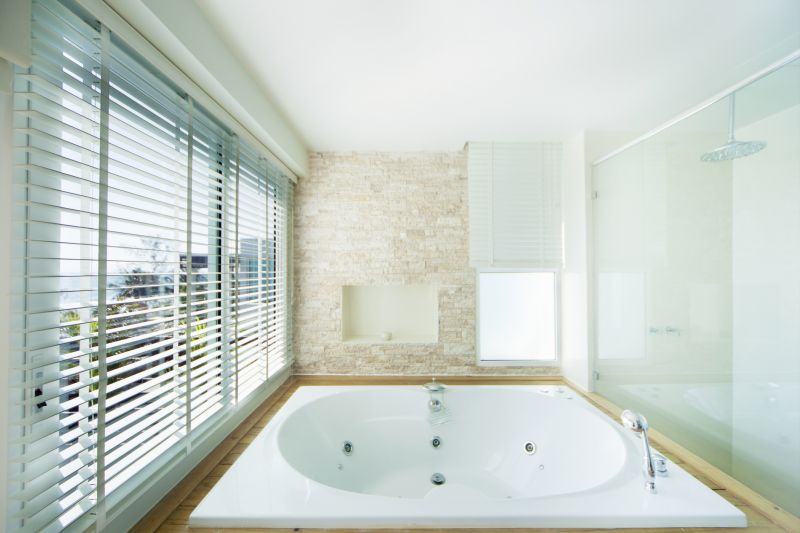Leading Products For Bathtub Refinishings To Revitalize Your Bathroom
Identify the most effective refinishing solutions that restore shine and protect your bathtub for years to come.
 Bathtub refinishing is a practical solution for updating the appearance of an aging or damaged bathtub without the need for full replacement. The process involves applying specialized coatings or resurfacing materials that adhere to the existing surface, providing a fresh and smooth finish. This approach can effectively conceal chips, scratches, and stains, restoring the bathtub's visual appeal while extending its usability.
Bathtub refinishing is a practical solution for updating the appearance of an aging or damaged bathtub without the need for full replacement. The process involves applying specialized coatings or resurfacing materials that adhere to the existing surface, providing a fresh and smooth finish. This approach can effectively conceal chips, scratches, and stains, restoring the bathtub's visual appeal while extending its usability.
Top Overall Option
Epoxy Coating Kit for Bathtub Refinishing
An epoxy coating kit designed for bathtub refinishing offers a durable, high-gloss finish suitable for various surfaces including porcelain, fiberglass, and acrylic. These kits typically include a primer, epoxy resin, and a topcoat, providing a comprehensive solution for a professional-looking result. Proper surface preparation and application are essential to maximize adhesion and longevity, making this type of product a versatile choice for both DIYers and professionals seeking consistent results.
Types of Products For Bathtub Refinishings
Epoxy Paints
Epoxy paints provide a hard, durable finish suitable for high-traffic bathroom surfaces and are resistant to stains and moisture.
Acrylic Coatings
Acrylic coatings offer a smooth, glossy finish with ease of application, ideal for quick refinishing projects.
Urethane Finishes
Urethane-based products are known for their chemical resistance and long-lasting sheen, suitable for bathrooms with heavy use.
Spray-On Resurfacing Products
Spray-on options allow for quick and even application, often used for smaller repairs or touch-ups.
Refinishing Kits
Complete kits include primers, coatings, and sealers designed for DIY bathtub refinishing projects.
Repair Pastes and Putty
Used to fill chips, cracks, and surface imperfections before applying the finishing coat.
Bonding Primers
Primers formulated to improve adhesion of coatings on various bathtub materials.
Non-slip Additives
Mixed into coatings to enhance safety by providing a textured, slip-resistant surface.
Sealants and Topcoats
Clear sealers and topcoats protect the refinished surface from moisture and wear.
Porcelain Repair Kits
Specialized for porcelain surfaces, these kits restore chips and minor damage effectively.
Fiberglass Surface Coatings
Designed specifically for fiberglass tubs, these coatings adhere well and provide a smooth finish.
Acrylic Enamel Paints
Enamel paints provide a glossy, durable surface suitable for bathroom fixtures.
High-Temperature Resistant Coatings
Formulated to withstand the heat and moisture typical in bathroom environments.
Eco-Friendly Refinishing Products
Products that minimize VOCs and emissions, suitable for environmentally conscious projects.
Quick-Dry Coatings
Designed for faster curing times, reducing project duration.
Heavy-Duty Protective Sealers
Sealers that provide extra protection against moisture ingress and staining.
Popular Choices
Widely used for their durability and glossy finish, epoxy kits are common for bathtub refinishing projects.
Chosen for their ease of application and smooth finish, these paints are popular among DIY enthusiasts.
Favored for quick application and even coverage, especially for small repairs.
Effective for fixing chips and minor surface damage on porcelain tubs.
Preferred for fiberglass tubs due to their adhesion and finish quality.
Popular for enhancing shine and protecting the refinished surface.
Increasingly used to improve safety on refinished surfaces.
Valued for reducing downtime during refinishing projects.
Commonly recommended to ensure proper adhesion on various surfaces.
Chosen for their chemical resistance and longevity in bathroom environments.
Popular for final protection and enhancing the durability of the refinished surface.
Complete kits are favored for their convenience and comprehensive application process.
Often selected for restoring porcelain surfaces with minimal disruption.
Used for their glossy finish and ease of application.
Popular for providing an extra layer of protection in high-use bathrooms.
Choosing the right products for bathtub refinishing requires understanding the different types of coatings available, their application methods, and compatibility with various bathtub materials. Common options include epoxy-based paints, acrylic coatings, and urethane finishes, each offering different levels of durability and finish quality. Proper preparation, including cleaning and possibly sanding the surface, is essential to ensure optimal adhesion and long-lasting results.
In addition to coatings, there are repair kits designed for spot fixes on chips or cracks, as well as primers and sealers that enhance bonding and durability. Some products are formulated specifically for certain bathtub materials such as porcelain, fiberglass, or acrylic, making it important to select a product suitable for your specific surface. Proper ventilation and safety precautions should be observed during application to achieve the best outcome.
Investing in quality products for bathtub refinishing can lead to a professional-looking finish that revitalizes your bathroom space. Whether you are a DIY enthusiast or hiring a professional, understanding the variety of available products can help you make informed decisions to meet your renovation goals. From initial surface preparation to the final coating, selecting the appropriate products ensures a durable and aesthetically pleasing result that can significantly improve the bathroom’s overall appearance.
Key Buying Considerations
- Compatibility with your bathtub material, such as porcelain, fiberglass, or acrylic.
- Durability and resistance to moisture, stains, and cleaning agents.
- Ease of application, especially if opting for a DIY project.
- Drying and curing times to fit your schedule.
- Finish options including matte, semi-gloss, or high-gloss for aesthetic preferences.
- Surface preparation requirements like cleaning, sanding, or priming.
- Safety precautions and ventilation needs during application.
- Compatibility with existing fixtures and fittings.
- Availability of repair kits for minor chips or cracks.
- Long-term maintenance and cleaning requirements.
- Environmental considerations, such as VOC levels, if relevant.
- Cost-effectiveness and value for the scope of your project.
- Brand reputation and product reviews for reliability.
- Availability of technical support or instructions.
- Compatibility with other bathroom fixtures and finishes.
